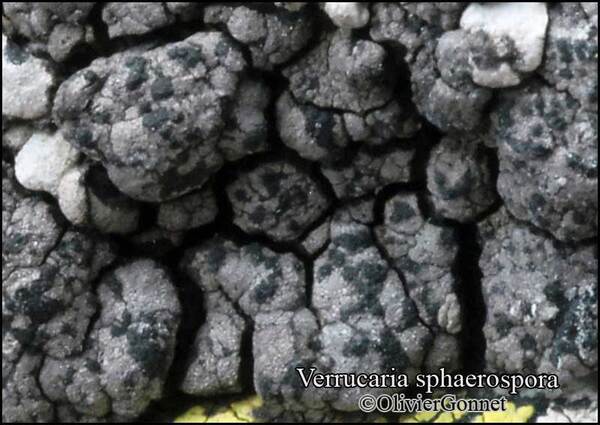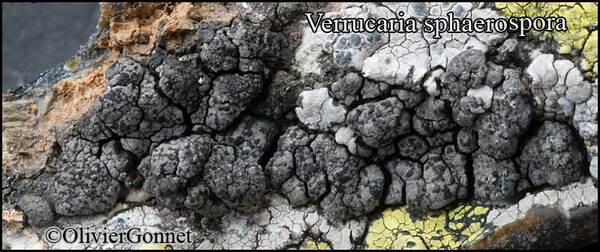Verrucaria sphaerospora Anzi
Cat. Lich. Sondr.: 110, 1860.
Synonyms: Catapyrenium sphaerosporum (Anzi) Arnold; Dermatocarpon anzianum Servít; Dermatocarpon pulvinulosum (Harm.) Zahlbr.; Involucrocarpon sphaerosporum (Anzi) Servít
Distribution: N - Lomb, Piem, Emil (Fariselli & al. 2020). C - Abr (Nimis & Tretiach 1999), Sar (Rizzi & al. 2011, Giordani & al. 2013). S - Camp (Nimis & Tretiach 2004).
Description: Thallus crustose, episubstratic, whitish grey to brown, areolate to subsquamulose, 0.2-0.4 mm thick, forming well-delimited, 1-3 cm wide patches, the areoles subangular to rounded, finally strongly convex, 0.5-2 mm wide, partly subdivided by fine cracks, attached by a central hyphal bunch. Cortex of 1-2 layers of brown cells, overlain by a thin (c. 10 µm), irregular epinecral layer; algal layer 50-200 µm thick; medulla white, subparaplectenchymatous. Perithecia black, often in clusters of 3-15, usually originating in the cracks subdividing the areoles, globose, up to 0.4 mm wide, totally or up to 2/3 immersed and then projecting with the convex tips, the ostiolar region often depressed. Involucrellum completely fused with exciple and hardly distinguishable from it, carbonaceous; exciple globose, (0.2-)0.3-0.4 mm across, the wall pale brown to blackish brown in inner part, merging with the black involucrellum in outer part to form a homogeneously 90-120 µm thick, black wall; hamathecium of periphyses and periphysoids, interascal filaments absent; hymenial gel hemiamyloid, I+ red (I+ blue at very low concentrations of I), K/I+ blue. Asci 8-spored, clavate, I-, fissitunicate, the wall thickened above, with an ocular chamber, dehiscent by extrusion of an endotunica to form a delicate rostrum, Verrucaria-type. Ascospores 1-celled, hyaline, broadly ellipsoid to subglobose, 9-12 x 7-8(-10) µm. Photobiont chlorococcoid. Spot tests: K-, C-, KC-, P-, UV-. Chemistry: without lichen substances.Note: a very characteristic species forming a complex of still poorly known entities growing on calciferous sandstone, often on walls, that probably belongs to Verruculopsis.
Growth form: Crustose
Substrata: rocks
Photobiont: green algae other than Trentepohlia
Reproductive strategy: mainly sexual
Poorly known taxon in need of further study
Commonnes-rarity: (info)
Alpine belt: absent
Subalpine belt: extremely rare
Oromediterranean belt: absent
Montane belt: rare
Submediterranean belt: extremely rare
Padanian area: absent
Humid submediterranean belt: extremely rare
Humid mediterranean belt: absent
Dry mediterranean belt: absent
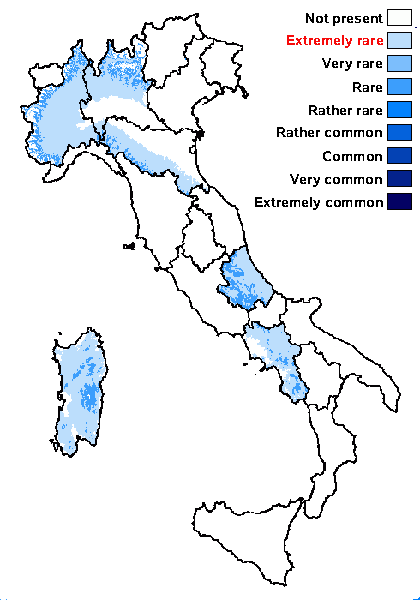
Predictive model
Herbarium samples
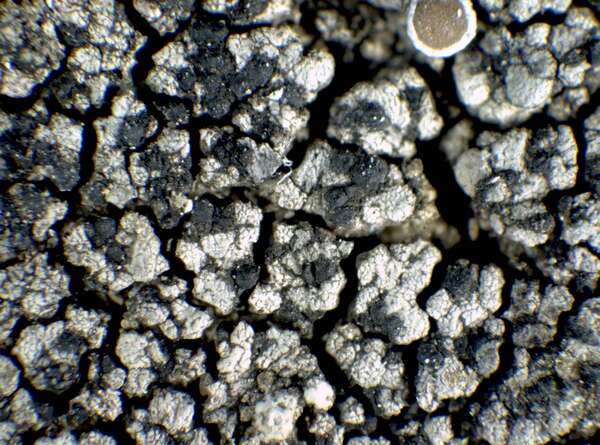

P.L. Nimis; Owner: Department of Life Sciences, University of Trieste
Herbarium: TSB (24330)
2001/12/03
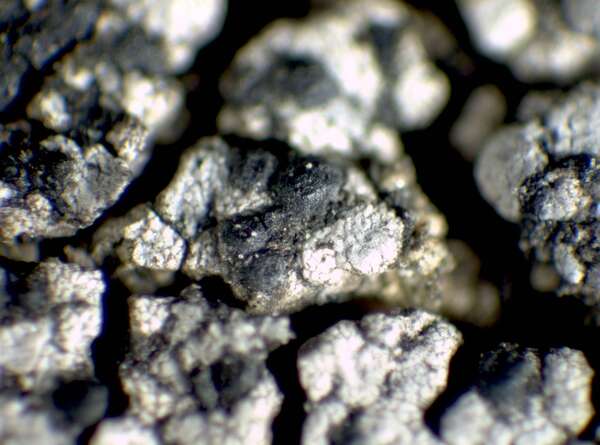

P.L. Nimis; Owner: Department of Life Sciences, University of Trieste
Herbarium: TSB (24330)
2001/12/03
Growth form: Crustose
Substrata: rocks
Photobiont: green algae other than Trentepohlia
Reproductive strategy: mainly sexual
Poorly known taxon in need of further study
Commonnes-rarity: (info)
Alpine belt: absent
Subalpine belt: extremely rare
Oromediterranean belt: absent
Montane belt: rare
Submediterranean belt: extremely rare
Padanian area: absent
Humid submediterranean belt: extremely rare
Humid mediterranean belt: absent
Dry mediterranean belt: absent

Predictive model
| Herbarium samples |


P.L. Nimis; Owner: Department of Life Sciences, University of Trieste
Herbarium: TSB (24330)
2001/12/03


 INDEX FUNGORUM
INDEX FUNGORUM
 GBIF
GBIF
